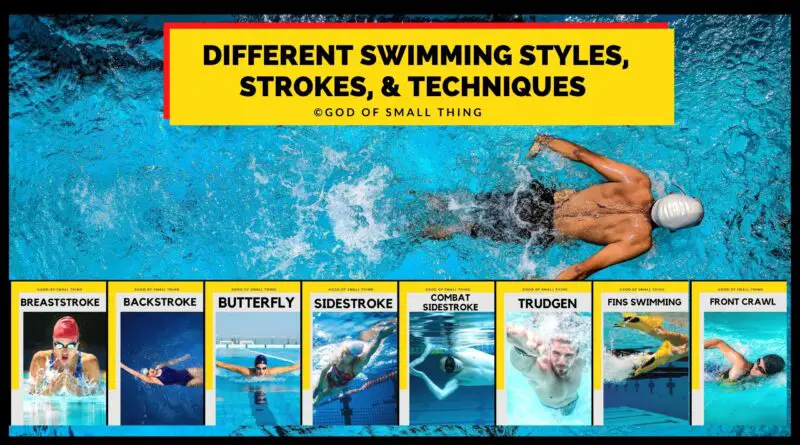Learn 8 Different Swimming Strokes, Styles & Techniques – God of Small Thing
The participant in the sport of swimming must move their entire body through (into) the water. Doesn’t it seem simple? But, in reality, it takes a lot of effort to overcome the drag that water creates due to its viscosity. Although you could feel lighter in the water, the drag prevents your muscles from ever relaxing while you’re going. This makes it possible to exercise muscles without endangering bone joints. Ten distinct varieties of swimming exercises are available. Let’s examine the various kinds of swimming kicks, swimming strokes, forms of swimming in the Olympics, and much more in more detail. So continue reading! Swimming strokes are a fun way to exercise if people find going to the gym or doing other sorts of exercise boring or challenging. It’s a great method to exercise outside as well. So, here are 8 Different Swimming Strokes and Styles with Techniques:
| S.N | Strokes |
| 1. | Front Crawl / Freestyle |
| 2. | Breaststroke |
| 3. | Butterfly Stroke |
| 4. | Backstroke |
| 5. | Trudgen |
| 6. | Sidestroke |
| 7. | Snorkeling |
| 8. | Combat Sidestroke |
Table of Contents
1. Front Crawl or Freestyle
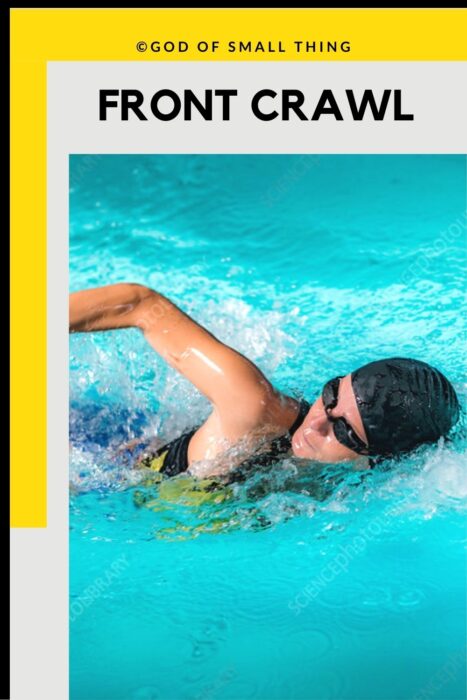
The normal swimming position is depicted here. Move your legs in a windmill motion while alternating your arms while lying on your stomach. You go in a specific direction, gradually forward. The freestyle stroke allows you to swim farther without tiring and is an excellent competition and exercise stroke. It achieves maximum speed while requiring the least amount of effort. In freestyle swimming, there is a Prone horizontal (face down) position. Alternating arm movements and flutter kicks help to generate the momentum needed to push the body.
This is the most common swimming stroke. This is the most natural stroke of all, and you can do it in any body of water, including a swimming pool. Swim straight on your torso while kicking your legs. However, because certain strokes keep your head underwater, it’s critical to maintain control of your breathing.
“Freestyle is definitely the best-known swimming stroke,” says Julia Russell, C.P.T., a former Olympic swimmer, NASM-certified personal trainer, and owner of Inside Out Fitness. “Not only is it the fastest and most efficient, but it’s also the easiest to master,” she explains.
Difficulty Level: Easy
How to do a Front Crawl or Freestyle Style Movements?
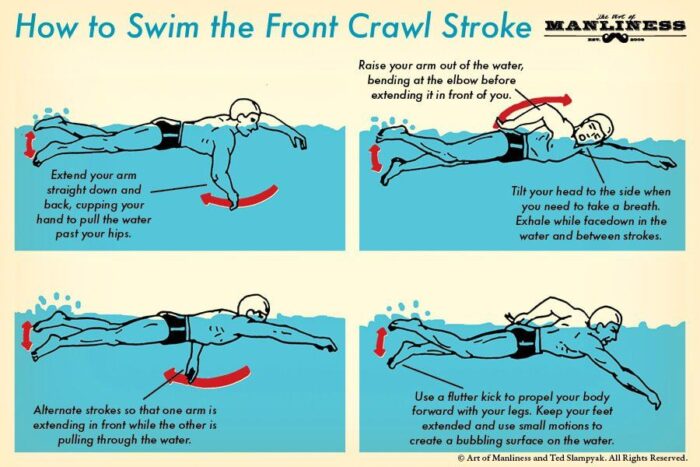
When it comes to freestyle tournaments, there aren’t many restrictions in place. Freestyle races are regularly held at distances ranging from 50 to 1500 metres. Swimming pros recommend starting with freestyle because it gives the body a complete exercise and allows a person to travel further while using less energy by using front crawl strokes.
Body movement
- When swimming freestyle, the body is horizontal and submerged face down.
- Only when breathing on either side does the head rotate; otherwise, it is always in a neutral position.
- The body rolls from side to side as it swims forward in the water.
Arms movement
- While the other arm is underwater recovering, one arm first extends.
- Lowering the forearm while lifting the elbow is how the down-sweep is executed. In order to move forward and backwards, one uses the upper arm.
- In-sweep involves pulling the water with one arm. The next motion is an up-sweep as another arm pushes the water.
- When the arms swing forward during recovery, the forearm unwinds.
Legs movement
- In freestyle, a flutter kick is employed. It describes fast-moving feet that are dispersed.
- Two directions are alternated during the flutter kick. One leg raises steadily while the other falls.
Watch Front Crawl or Freestyle Style Tutorial video
2. Breaststroke
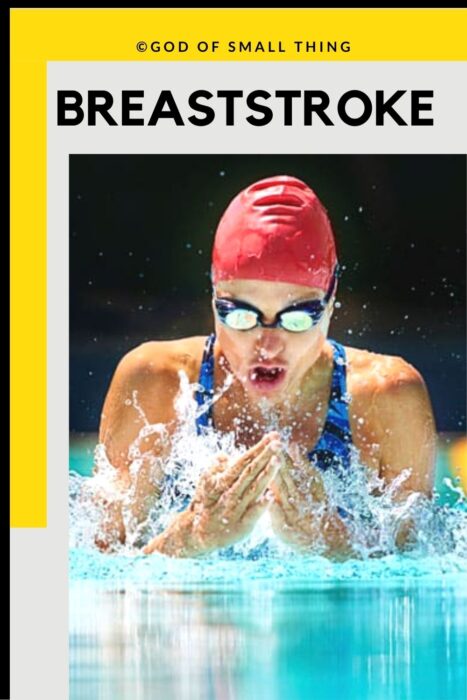
Flutter your arms in a half-circle in front of your body while floating with your tummy facing down. You can propel yourself forward by bending your legs and kicking back with proper timing. This is an excellent workout for folks who swim for exercise. Breaststroke may be a more relaxed and slower option for beginners than freestyle. The only difference is how you propel your body forward using propulsion.
Because it is less difficult than various swimming strokes, it may not be your first choice for a high-intensity workout. Russell, on the other hand, thinks it’s a great way to mix things up and focus on other muscle groups because it demands such a different movement pattern than freestyle and backstroke.
Though the tempo of breaststroke, which is quite different from freestyle and backstroke, can be tricky to nail, “Once you get it, you get it for life,” says Julia Russell, C.P.T., a former Olympic swimmer, NASM-certified personal trainer. “It’s like riding a bike,” she adds.
Difficulty Level: Easy
How to do Breaststroke Style Movements?
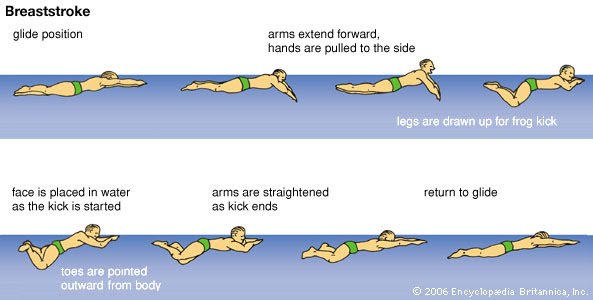
The breaststroke is the most popular swimming kick and style of all. A swimmer’s head is raised while his body is lowered into the water. As a result, breathing is simple. Breaststroke is preferred by many amateur and beginner swimmers over all other swimming strokes. Another fascinating data reveals that breaststroke is the slowest swimming technique. Choose breaststroke if you wish to swim in a relaxed manner. According to fitness experts, breaststroke is a cardiovascular activity that strengthens the heart and promotes blood circulation.
Body movement
- You continually modify your body posture when swimming the breaststroke. It changes from being horizontal to being inclined as a person starts to swim.
- As the body moves forward in the water, the torso assumes a 45-degree angle above the water.
- The head stays in line with the body the entire time you’re swimming.
Arms movement
- The arms are initially extended forward.
- The initial pull causes the arms to go forth, then backwards, and eventually downward.
- To the level of the shoulder blades, the elbows are extended.
- As the arms move back, hands under the chest move towards one another.
Legs movement
- In breaststroke, frog kicks or whip kicks are employed.
- During the arm pull phase, the legs are stretched.
- then the knees bend and move towards the hips.
- Swimmers who use the breaststroke move their feet forward and backwards.
Watch the Breaststroke Style Tutorial video
As we are talking about the Breaststroke Strokes Swimming Style and it is one of the best cardio workouts for weight loss. Here is the article on Best Types of Cardio Workouts for Weight Loss with tutorials & Benefits – Best Types of Cardio Workouts
3. Butterfly Stroke
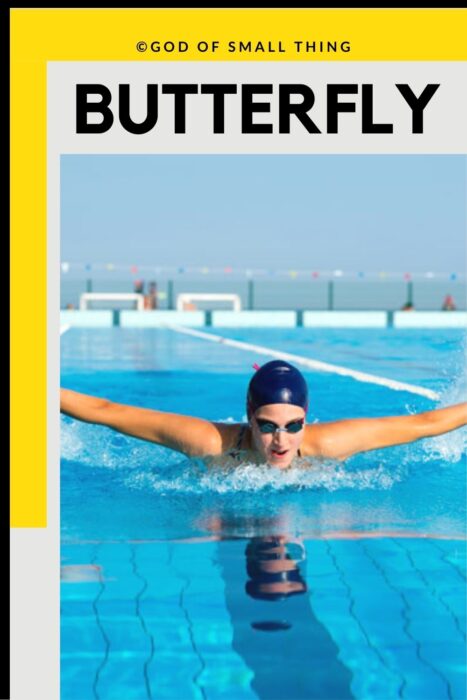
The Butterfly is a popular competitive stroke that is also a fantastic exercise since it challenges swimmers to improve their swimming technique. This could also be because it tests an experienced swimmer. Your legs perform a dolphin kick, which entails keeping them together while kicking in a bobbing manner. Even though learning this stroke is exceedingly difficult, if you register in private swimming classes, you will be able to persevere.
A swimming instructor will teach you the proper technique and coach you until you have mastered it. However, once there, the average person engages in this hard exercise and burns approximately 900 calories in an hour. “It’s a pretty unusual movement. Plus, it utilizes just about every muscle you have,” explains Julia Russell, C.P.T., a former Olympic swimmer, and NASM-certified personal trainer, “It really gets your heart rate up there.”
The butterfly stroke is the most recent swimming trend and style. It began as a breaststroke branch in 1933. Sydney Cavil, an Australian swimmer, is credited with popularising this stroke. Because both arms and legs are pulling and pushing at the same time, the Butterfly stroke is faster than the Freestyle stroke at its peak. The stroke, however, slows down while the patient recovers. As a result, the butterfly stroke becomes a slower overall swimming technique. Experts agree that the toughest swimming stroke is also the best for improving muscle strength and conditioning.

Difficulty Level: Hard
How to do Butterfly Stroke Style Movements?
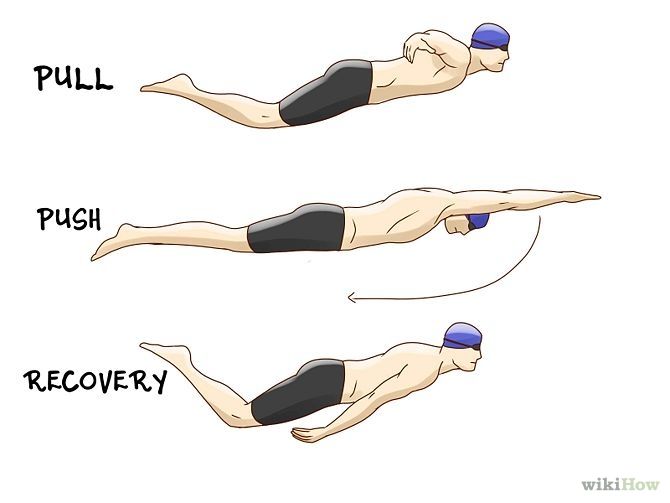
The butterfly stroke is done while lying down. It is relatively tiring and challenging in comparison to other swimming strokes. During this stroke, the chest and hip move in wave-like motions up and down the water’s surface.
Body movement
- The body starts to float horizontally on the chest as swimming begins.
- With the face in the water, the head is always parallel to the torso.
- When the body accelerates, wave-like motions appear.
Arms movement
- As the body recovers, more and more arms come in.
- Due to the sagging chest, the arms briefly stretch in a straight position.
- A catch is defined as a line of palms and forearms pointing backwards.
- After then, there is a continuous in and out-sweep.
- Finally, the body can relax better thanks to release and recovery.
Legs movement
- The swimming stroke known as the butterfly employs the dolphin kick.
- With pointed feet, a person starts to whip their legs.
- As the hips rise, the legs rise in unison.
- The cycle continues, with legs whipping in place, legs straightening in step with the hips, and so on.
Watch the Butterfly Stroke Style Tutorial video.
4. Backstroke
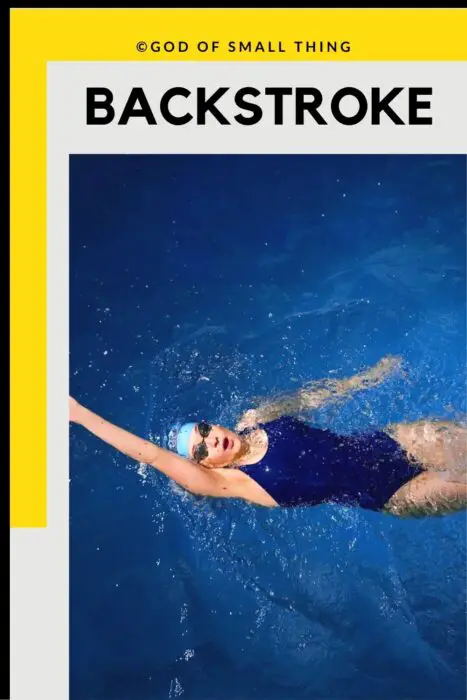
On your back, wiggle your legs and move your arms in a windmill motion. In many aspects, it is similar to freestyle, but you swim backwards on your back. Several doctors recommend this practise for patients with back problems or those wishing to strengthen their back muscles. However, because this stroke may be more difficult, you may consider getting individual swimming lessons to learn the proper technique.
Backstroke swimming requires you to swim with your back in the water, as opposed to other swimming strokes that allow you to swim with your face in the water. Simply put, it is the inverse of freestyle, with the strokes performed while lying on your back. “Backstroke is extremely useful when you need a bit of a rest period,” says Julia Russell, C.P.T., a former Olympic swimmer, and NASM-certified personal trainer who “really wants to strengthen your abs and back muscles.”

Front crawl (Freestyle) is the inverse of backstroke, often known as back crawl. Harry Hebner popularised the backstroke. The backstroke became a competitive swimming event at the 1990 Olympics in St. Louis. The difficulty of breathing when swimming front crawl was one of the key causes that led to its discovery. As a result, Backstroke evolved into Back Crawl, which is the polar opposite of Backstroke. Backstroke, they believe, improves physical posture.
Difficulty Level: Medium
How to do Backstroke Style Movements?
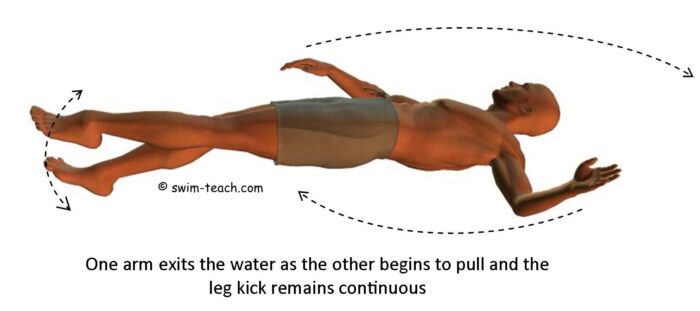
Backstroke is the only competitive stroke performed on the back. The head is in an upright neutral position. Except for one significant variation, it is quite identical to the Front Crawl kind. It is one of the most difficult swimming styles.
Body movement
- The corpse is floating horizontally after being rotated rearward.
- The body rolls from one side to the other in response to arm motions.
- The head is neutral and the face is up.
Arms movement
- With arms extended, water is pushed backwards.
- The motion is shaped like a S.
- During recovery, arms go from one hip to the other.
- The arms are held straight while in rehabilitation.
Legs movement
- When swimming backstroke, a flutter kick is a swimming technique used.
- Kicks in a vertical direction alternately up and down with pointed feet.
Watch the Backstroke Style Tutorial video.
5. Trudgen

The Trudgen swimming stroke is also known as the East Indian stroke or racing stroke. It evolved from the sidestroke and was named after English swimmer John Trudgen (1852–1902). English swimmer John Trudgen invented the “Trudgen” swimming method. Another term for it is the Racing Stroke. This movement is a version of the sidestroke. Forbes Carlile’s inquiry uncovers when and how John developed the particular Trudgen technique that made him the quickest sprinter of his time.
Swim predominantly on one side using an overhand action and alternating arm lifts out of the water. When the left arm is over the head, the legs are spread out for a kick; as the left arm lowers, the legs expand before being brought together with a sharp scissor kick. As the right arm is thrust forward over the water, the left arm is extended once more. Every other stroke is a scissor kick, which entails spreading the legs apart and then snapping them together in a “snap” motion.
“Keeping flat on his chest with his head carried high in the air, (John) Trudgen startled onlookers by swinging each arm alternately over the water and making one horizontal breast-stroke kick to each cycle of the arms so that his body lifted and progressed in jerky leaps,” Carlile writes of John’s victory in 160 yards handicap on August 11, 1873, at the Lambeth Baths, London.
Difficulty Level: Medium
How to do Trudgen Style Movements?
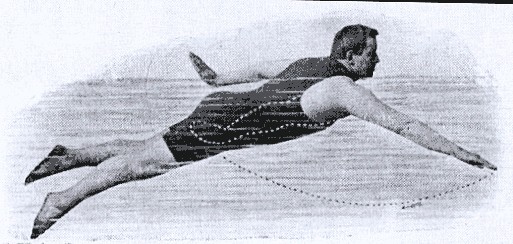
It is also known as the racers stroke and was named after the English swimmer John Trudgen. It began as a sidestroke. You mostly stay on your side throughout this stroke.
Body movement
- The body shifts from the stomach to the side.
- It should be situated below the surface of the water.
- The body only rises in response to breathing and arm motion.
Arms movement
- Keep arm limbs to the surface.
- The elbows are inclined downward.
- Your arms are outstretched in front of you, palms downward.
- The arms loop water to the rear in alternation as you move forward.
Legs movement
- Legs switch between dolphin and scissor kicks.
- The feet are arranged in a straight line.
- The torso is lifted, as are the legs.
- A scissor kick is referred described as such when the hands move forward.
- The feet come together in a dolphin kick as the arm strokes resume.
Watch the Trudgen Style Tutorial video.
As we are talking about the Trudgen Swimming Strokes Style. Here is the article on How to lose weight fast? – Expert’s Guide
6. Sidestroke
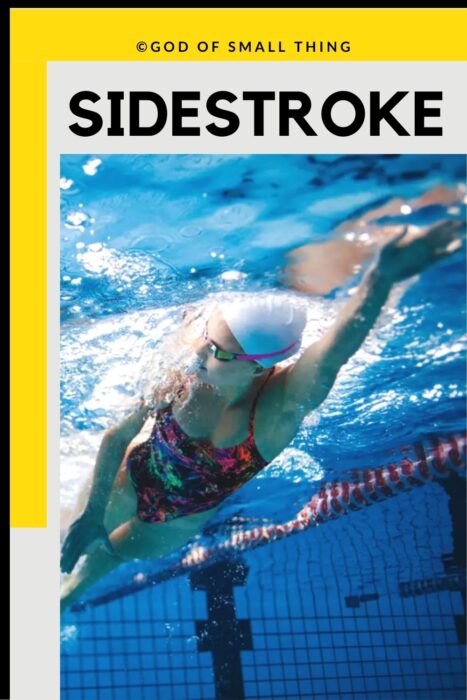
Despite the fact that it is not one of the four approved competitive swimming strokes, the sidestroke is an excellent survival tactic. This method is commonly used by lifeguards since it allows you to grab onto someone else and hold them above water while swimming. Lie on your side and scissor your legs together to move forward. Because your legs do the majority of the propulsion, it’s an excellent leg workout.
This form of stroke is less popular than the others since it is rarely used in swimming competitions. Most lifeguards use it because it allows you to pull a partner along with you. As the name implies, you swim on your side, propelling yourself forward. Bring your hands together in front of your chest and dart your arms back and forth in an alternating manner. Although tough to learn, this knowledge is critical for supporting others.
The sidestroke method is used by the swimmer by leaning to one side and creating asymmetrical arm and leg actions. It is frequently used for long-distance swimming. Swimmers have utilised this technique to relax after a hard hour of swimming. Even better, the sidestroke is employed sparingly to save lives. Swimming pros suggest employing the sidestroke approach because it provides young swimmers with the versatility they need to flourish in the sport.
For example, in his book A Treatise on the Utility of Swimming, author H Kenworth writes, “Until recently, it was usually considered that breast or belly swimming was the fastest technique; however, this notion has proven false.” The sidestroke is now widely recognised as the superior technique, and young swimmers would be well to practice it properly.
Difficulty Level: Medium
How to do Sidestroke Style Movements?
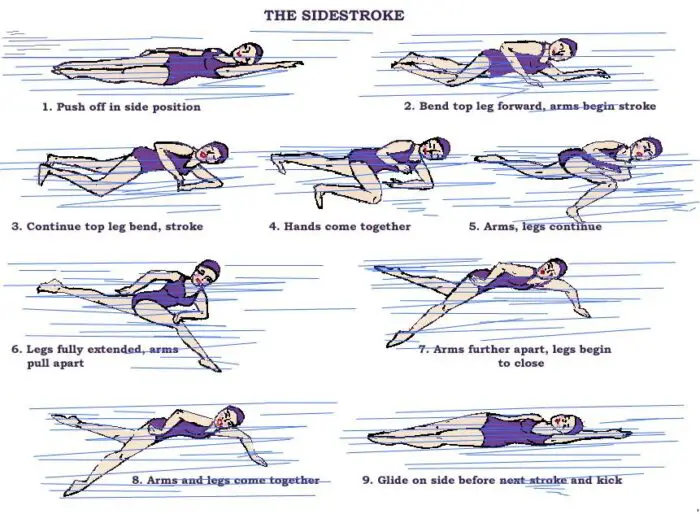
One of the oldest swimming techniques for rescuing drowning victims. A scissor kick and asymmetric underwater arm movements can be performed with only one arm. The body is positioned to the side for the duration of the stroke. The head is always above the water’s surface.
Body movement
- To begin, the swimmer lies on one side with their legs spread wide.
- On the side of the torso, the upper arm is flat.
- The head is positioned in line with the spine, and half of the face is submerged.
Arms movement
- The elbow of the lower arm, which is being thrust back against the water, is bent.
- With the palm up and the hand reaching in front of the chest, one does an in-sweep.
- The lower arm extends back to the front as the upper arm pushes against the water.
Legs movement
- In sidestroke, a scissors kick is employed.
- The foot and knee of the upper leg are brought to the chest while the upper leg is bowed.
- The foot then moves towards the back of the body as the lower leg bends.
- Flexible synchronisation between the arms and legs is essential.
Watch the Sidestroke Style Tutorial video.
7. Snorkeling

Snorkeling is the term used to describe swimming while fully clothed. It is primarily a leisure activity. A diving mask, as well as a tube (snorkel), are required and are frequently worn in conjunction with a pair of fins. The mask allows for clear vision underwater, the snorkel makes breathing easier, and the swim fins make moving around easier. Snorkeling does not necessitate specialized knowledge or a lot of physical exertion.
Snorkeling and scuba diving are commonly compared; however, scuba requires going deeper than snorkeling, which requires floating near the surface. Cays, islands, and barrier reefs are the most popular snorkeling destinations. Snorkeling is used by scuba divers on the surface, participants in underwater activities such as underwater hockey and underwater rugby, and members of search and rescue teams.
Snorkeling is a popular pastime in tropical resort areas, in particular. It provides the opportunity to see undersea organisms in their native habitat without the complicated equipment and training required for scuba diving. Because of the minimum effort required, it serves as the foundation for the two surface disciplines of the underwater sport of finswimming and is popular to people of all ages.

Difficulty Level: Easy
How to do Snorkeling Style Movements?
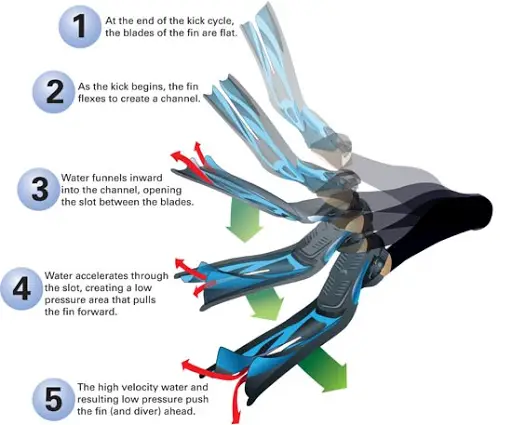
Snorkelling is the action of swimming on or through water while wearing a diving mask, a snorkel-shaped breathing tube, and generally swimfins. In cooler water, you can also wear a wetsuit. This equipment allows the snorkeler to breathe while face-down at the surface and see undersea sights for extended periods of time with no effort.
Body movement
- The body must be straight in a horizontal position.
- Swimming is best done with the head submerged.
- The body doesn’t sway to either side because breathing is done through the snorkel.
Arms movement
- As the other heals, one arm starts to reach underwater.
- Lowering the forearm while lifting the elbow is how the down-sweep is executed.
- In order to move forward and backwards, one uses the upper arm.
- In-sweep involves pulling the water with one arm. The next motion is an up-sweep as another arm pushes the water.
- When the arms swing forward during recovery, the forearm unwinds.
Legs movement
- The same flutter kick used in freestyle is used here. It describes fast-moving feet that are dispersed.
- Two directions are alternated during the flutter kick.
- One leg raises steadily while the other falls.
Watch the Snorkeling Style Tutorial video.
8. Combat Sidestroke
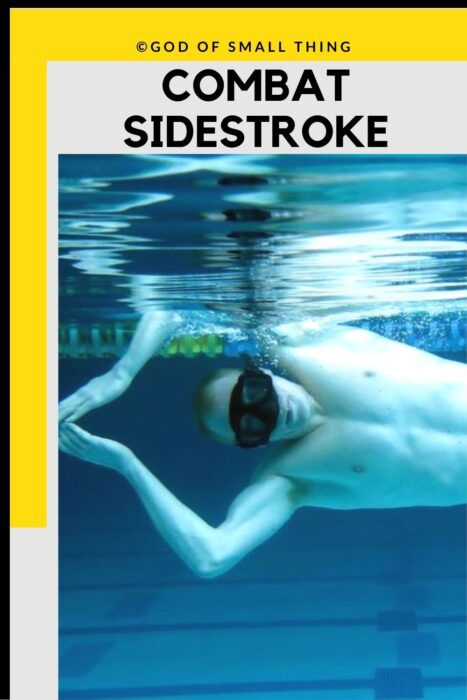
CSS (Combat Sidestroke) is a version of the sidestroke. The US Navy SEALs were the first to use it. Terry Laughlin of Total Immersion Swimming and former Navy SEAL Stew Smith (CSCS) helped to develop this sidestroke. It is claimed to be extremely effective and relaxing since it mixes the sidestroke, front crawl, and breaststroke. The military sidestroke method is used by US Navy SEALs to transport heavy equipment underwater.
The combat side stroke, or CSS, is a version of the side stroke devised and trained by the United States Navy SEALs. The Combat Swimmer Stroke was developed for the United States Navy Seals by former Navy SEAL Stew Smith (CSCS) and Terry Laughlin of Total Immersion Swimming. As one of the strokes used to determine eligibility for the Basic Underwater Demolitions/SEAL course.
CSS was designed to be used with or without swim fins (flippers), with the only difference being that when swim fins are worn, the swimmer’s legs will always kick normally rather than doing a scissor kick. Prospective SEAL candidates can use this stroke in the SEAL physical screening test (PST), which consists of a 500-yard swim in 12 minutes and 30 seconds.
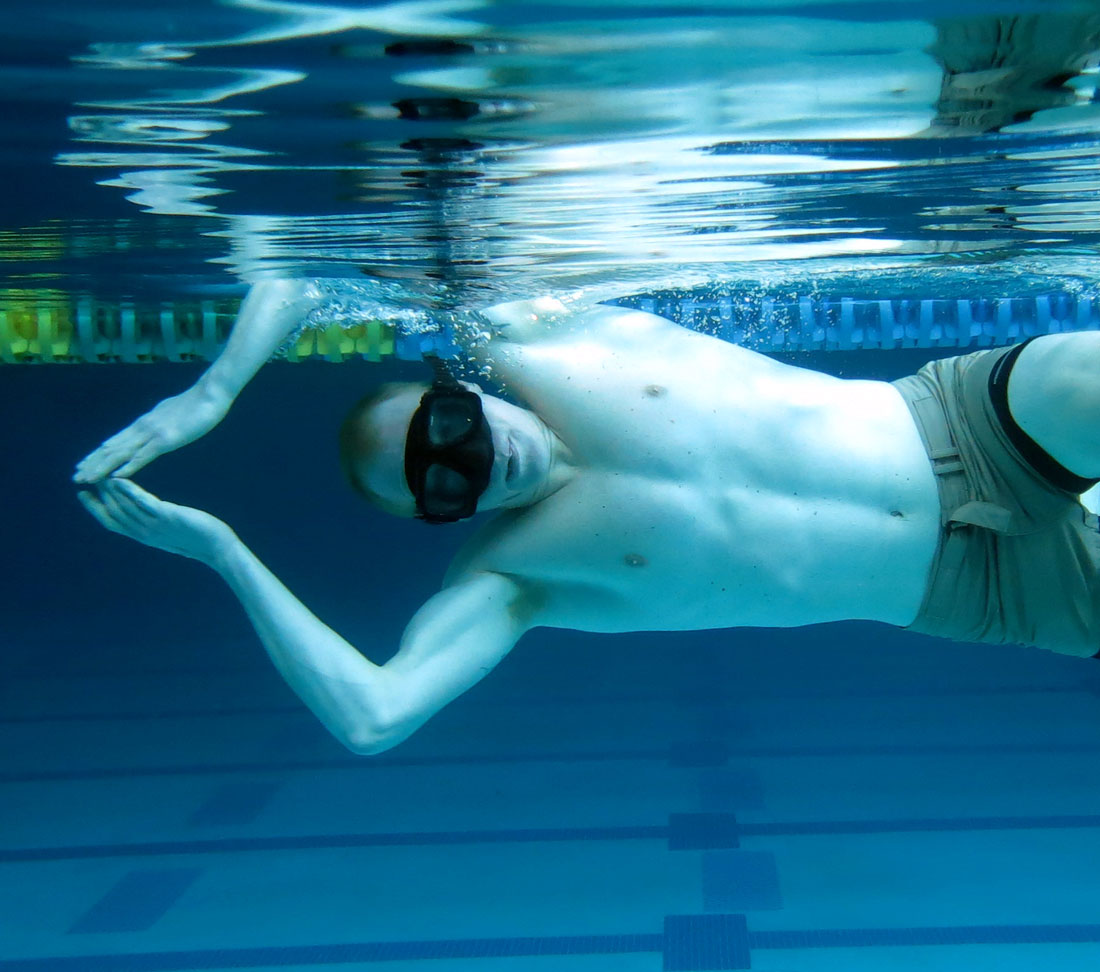
Difficulty Level: Hard
How to do Combat Sidestroke Style Movements?

The fighting side stroke, an improved version of the standard sidestroke, is a relaxing and successful swimming technique. The CSS combines breaststroke, front crawl, and sidestroke. The battle side stroke improves swimming efficiency and decreases body profile in the water, making the swimmer less likely to be observed during combat operations if surface swimming is required.
Body movement
- The body should be flat underwater.
- In order to breathe while floating, the body is shifted to either side.
- The body ought to be as close to the surface as is practical.
Arms movement
- Every arm action during the stroke happens underwater.
- The arms are extended over the head in a streamlined manner.
- To help the body rotate from one side to the other, the shoulders are lowered.
Legs movement
- The legs exert the most effort when combating sidestroke.
- Its main objective is to fast advance the body.
- Leg action begins with a scissor kick.
- The bottom leg extends the body back while the leg closest to the ground pulls the body forward.
Watch the Combat Sidestroke Style Tutorial video.
Some Frequently Asked Questions
Swimming is a challenging sport. The four compulsory events—freestyle, backstroke, butterfly, and breaststroke—must be mastered by a competitive swimmer. For beginners, using your arms and legs in any synchronised motion while attempting to maintain your head above water may seem like a difficult manoeuvre, but with the right instruction, it all comes naturally.
– The Freestyle Stroke – Together with the breaststroke, the freestyle is among the simpler strokes to learn. It does take coordination between the legs and arms, as well as head motions and breathing, to perform the freestyle stroke. For this stroke, the head is forward and down as the body is propelled through the water by the combination of alternately kicked legs and full-reaching arm strokes with cupped hands acting as paddles.
– The Butterfly Stroke – The hardest stroke to master but the most entertaining to watch is the butterfly. The butterfly appears to contradict science, but it is possible if the swimmer has strong enough legs and upper body. It entails the person paddling back under the water while spreading their arms out like wings above the water to drive their body through the water.
– The Breaststroke – Although it is thought to be one of the slowest swimming strokes, the breaststroke is one of the best for long swims. It is one of the trickier swim strokes to master, along with the butterfly. You can do it by putting your hand straight through the water, turning around, and waving your hands back to your hips.
– The Backstroke – For those recreational swimmers who enjoy gazing up at the clouds, the backstroke is a popular stroke. For leisure swimmers, the face never leaves the water’s surface; however, for competitive swimmers, there is a turn at the end of the pool’s length. You’ll be paddling backwards while lying on top of the water for the bulk of the swim.
Breaststroke
The easiest and slowest stroke is the breaststroke. One of the first strokes taught to beginner swimmers is this one. This is also due to the fact that you do not need to submerge your head. Start the breaststroke by diving into the water on your stomach. Make a half-circle with your arms in front of your body. It will resemble a frog somewhat. Your legs will kick out like a whip. Bring them close to your body and then move them forth in a half circle.
Tips:
– Float on your front with your face in the water, extending your body out. Your hands should be united in front-facing arm positions.
– Stretch your toes and maintain long legs.
– Stretch your arms out in front while submerging your head in the water. As you stroke, incline your thumbs downward.
– As you bring your arms together, raise your head to take a breath.
Butterfly
The butterfly is a terrifying manoeuvre for amateur swimmers. The hardest stroke to master, it takes a lot of strength before you can start to match the other strokes’ speeds. With a rate of about 820 calories burned per hour, it is also one of the best calorie burners. That’s comparable to a moderate run or rock climbing.
But it’s improbable that you’ll be able to maintain it for an entire hour because it requires so much effort to swim in that manner. Therefore, concentrating only on the butterfly is generally not a good idea unless you’re trying to fit a high-intensity workout into a short period of time.
This interactive simulation serves as an introduction to differentiating between competitive and resting swim strokes. Additionally, you may match and contrast the upper body and lower body action for each stroke with this simulation. The ultimate learning objective is to provide you with a level of fundamental information to boost your level of comfort and confidence before you enter the water.
This interactive learning activity will help you to:
– You will be able to classify, contrast, identify, and identify the differences between competitive swim strokes and resting swim strokes.
– Choose, match, and remember the appropriate upper- and lower-torso movements for the following. Swim Strokes While Rested:
Basic Backstroke and Sidestroke.
The basic answer to the question “Does swimming build muscle?” is “yes,” but if you want to get “ripped,” you might also need to incorporate other types of exercise and become familiar with your different muscle fibre types. Since you are trying to go forward through the water, swimming is essentially a form of resistance exercise. This will eventually result in favourable muscle adaptations (read: you’ll get stronger), just like with any resistance exercises. But you might need to use more intense forms of resistance if you want to develop bigger muscles.
The body’s major muscle groups receive a decent workout with all swimming strokes, including the abs, back, forearms, shoulders, hamstrings, and glutes. Tracy claims that by varying your strokes, you can more effectively target particular muscle areas.
When it comes to swimming, many people believe they’ve reached their limit. They hold the opinion that swimming is a skill that must be learned at a young age or you’ll never be able to accomplish it. Nothing could be further from the truth in actuality. There is no upper age limit for beginning swimming instruction and reaping its rewards. It doesn’t matter if you’re 3 or 93; neither is relevant. Swimming is perhaps the best activity for us as we become older. Our bodies remain strong, flexible, and lean because of the low-impact nature and additional resistance provided by the water.
The interesting thing is that adults typically retain information faster than children because they have more tolerance and are better at accepting criticism.
Swimming requires a variety of strokes. In swimming, the butterfly, backstroke, breaststroke, and freestyle are the four main strokes. As per Gold Class Swimming, swimmers breathe every two, three, or four strokes. Michael Phelps, however, breathes during each stroke.
As he inhaled between each stroke, Phelps’ rhythm improved. The GOAT Olympian was able to obtain more air thanks to the method. During each stroke, he would lift his head, which improved his balance. Most swimmers don’t breathe between each stroke, but the illustrious Olympian does in order to keep his rhythm and equilibrium. He changed his swimming style to one that better suited his physiology.
Butterfly
Although it’s the most challenging to learn and most definitely not for beginners, Butterfly is the best exercise for burning calories.
– About 450 calories are burned on average while swimming for 30 minutes.
– It is the most efficient all-around stroke for muscle strengthening and toning.
– It improves upper body strength by training the muscles in your chest, stomach, arms (especially your triceps), and back.
– It helps to improve posture by stretching out the body and increasing flexibility and suppleness.

